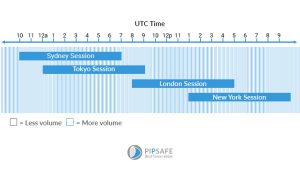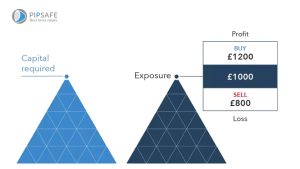Table of Contents
Forex Market Trading Hours
Because the currency exchanges in North America, Europe, Asia, and Australia are open at varying and frequently overlapping periods, the forex market is available twenty-four hours a day, five days a week. Exchanges located throughout the globe offer forex trading from 5 pm EST on Sunday to 5 pm EST on Friday. The main reason why forex trading is possible around the clock is the disparity in worldwide time zones. So the answer to the question “What time forex market close?” is never.
Know the global forex trading hours
People keep asking, “When forex market open today?” or “What time forex trading close?” The forex market hours are those during which participants from all over the world can purchase, sell, trade, and speculate on foreign currencies. On weekdays, the forex market open time is at any time, but on weekends, it is closed.
US forex market open time is at 8:00 am EST, and this time has the highest activity and liquidity. In other words, New York forex trading hours are one of the busiest ones.
Except on weekends, this market is accessible anytime because of its multi-time zone operations. This break becomes more compressed with time zone shifts. US forex market open time is on Sunday at 5:00 pm local time. It closes at 5 pm on Fridays and reopens for trading 48 hours later to start the following week. Forex traders can conduct trades on the market whenever available to the public. Depending on the session you’re in, trading conditions can change.
The forex market operates 24 hours a day but has core trading hours during overlapping sessions
We’ll discuss the different forex market open time in the following. Trading hours for the forex market are determined by the times each participating nation opens for business. Although there are overlaps in periods, it is widely acknowledged that the following times are the busiest in each region:
8 am to 5 pm (EST) in New York.
7 pm to 4 am. (EST) in Tokyo.
3 pm to 12 am. (EST) in Sydney.
3 am to 11 am. (EST) in London.
As you’ve seen, Japan forex trading time is 7:00 pm (EST). There are other essential parts you may want to know about opening hours; for example, the forex market in Singapore opens at 9:00 am and closes at 5:00 pm SGT. The following chart displays the actual market hours in each location in UTC time and the times when those sessions overlap. Check it out if you want to know, “What forex trading session is it now?”

New York and London are the two most crowded time zones. The busiest time is during the overlap of these two trading sessions (New York forex market open time and London afternoon). Trillions of dollars are exchanged there, making up most of the day’s trading volume.
The WM/Reuters benchmark spot and future foreign exchange prices are currently established. Many money managers and pension funds utilize the rates set at 4 pm. London local time for daily pricing and valuation.
Understand when major currency pairs are most actively traded
Compared to traders in equities markets, foreign exchange (forex) dealers enjoy the luxury of more highly leveraged trading with lower margin requirements. It would be wise for you to become familiar with the most frequently traded currency pairings before diving deeply into the hectic world of forex. Six of the most commonly traded currency pairings in forex are shown here.
EUR/USD: Trading the “Fiber”
The EUR/USD currency pair is the most traded, probably due to the global dominance of the US and European single-market economies. According to the most recent BIS poll, its proportion of the whole market was 22.7%. This is a decrease from the 24% market share in the earlier 2019 poll. Tight spreads are guaranteed for traders due to this pair’s substantial daily volume and liquidity.
Generally, there is a positive correlation between the British pound and the US dollar (GBP/USD) and a negative correlation between the EUR/USD and the Swiss franc (USD/CHF). This is because the British pound, the euro, and the Swiss franc have positive correlations.
USD/JPY: Trading the “Gopher”
The USD/JPY was the next most traded pair; it had good liquidity and a 13.5% market share, marginally higher than its previous 13.2%. This duo has demonstrated sensitivity to political emotions prevailing in the Far East and the United States.
It correlates positively with the USD/CHF and USD/CAD currency pairs. This association is because the base currency is the US dollar in all three pairs. The value of the yen in relation to the US dollar and the Bank of Japan’s interest rate adjustments impact the USD/JPY exchange rate.
GBP/USD: Trading the “Cable”
9/5% of the forex market was accounted for by trading in the GBP/USD currency pair. Once more, the strength of the US and British economies is reflected in this pair’s popularity and volume of trading.
With the USD/CHF and the EUR/USD, the GBP/USD typically exhibits a negative and positive correlation, respectively. This is because the euro, Swiss franc, and British pound sterling have positive correlations.
USD/CNY: Trading the Yuan
The relationship between the US dollar and the Chinese renminbi, also referred to as the yuan, is represented by the USD/CNY currency pair. From 4.1% of the market share in daily forex trades, it increased to 6.6%.
Due to the erratic nature of the trade relationship between the US and China, traders of USD/CNY have many options for speculative trading. Developments in that connection should be kept in mind by those interested in the USD/CNY, as they may impact the pair’s price.
USD/CAD: Trading the “Loonie”
Three years ago, the USD/CAD currency pair’s market share was 4.4%; however, it has since climbed to 5.5%. The price of this pair will be impacted by interest rates in both the US and Canada, which will affect the values of the individual currencies. Furthermore, as oil is a significant contributor to Canada’s economy, its price will influence the value of the Canadian dollar. This may then impact the currency pair.
Because the U.S. dollar is the quote currency in these other pairs—AUD/USD, GBP/USD, and EUR/USD—the USD/CAD pair tends to correlate with them negatively.
AUD/USD: Trading the “Aussie”
After formerly holding a 5.4% portion of the forex market, the AUD/USD currency pair now has a 5.1% share. Because the U.S. dollar is the base currency in these pairings—USD/CAD, USD/CHF, and USD/JPY—typically has a negative connection with them.
Australia’s currency’s value is directly correlated with the importance and magnitude of its exports to its economy. Consequently, a decline in that figure may impact the value of the AUD/USD currency pair, strengthening the US dollar relative to the Canadian dollar. The price of a currency pair may also be impacted by the link between the interest rates set by the various central banks.
The EUR/USD pair has the highest trading volume and is the first on the list of the most frequently traded currency pairs. Each of the six currency pairs provides the liquidity traders require to turn a profit.
However, several variables, including trade relations, shifting interest rates, economic instability, national conflicts, and even war, can impact certain currencies (and consequently pairs). Therefore, before you jump into the forex market, ensure you’re up to speed on such news and information to select the most profitable currency pairs to trade.

Leverage the high liquidity hours for your trades
As you may know, leverage increases your exposure to an underlying asset by utilizing a margin deposit. Essentially, your provider is lending you the remaining amount while you only contribute a small portion of the trade’s total worth. The leverage ratio is your overall exposure divided by your margin. Let’s take an example where you wish to purchase 1000 corporation shares at 100p each share. With a stockbroker, you must spend 1000 x 100p for a £1000 exposure to initiate a traditional trade (not including commission or other costs). Your thousand shares are now worth 120p a piece if the company’s share price increases by 20p. From your initial £1000 investment, you would have profited £200 if you closed your trade.
You would have lost £200, or one-fifth of the price you paid for the shares, if the market had turned against you and the company’s shares had dropped by 20p. Alternatively, you might have started your trade with a leveraged supplier, who might have required 10% margin for the identical shares.
In this case, opening the trade would only need you to spend £100, or 10% of your £1000 exposure. You would still benefit by £200 even if the company’s share price increased to 120p but at a much lower expense.
Two times your initial deposit, or £200, would have been lost if the shares had dropped by 20p.

You ought to profit from the times when the financial markets are bustling with activity and have a large number of buyers and sellers. Because there are more traders in the market during these high liquidity hours, purchasing or selling assets is usually simpler because of the potential for tighter bid-ask spreads and better prices. It means that if you want to maximize your trading results, you should consider placing your transactions during certain times.
London and New York trading sessions from 8 am-12 pm London time offer high liquidity
So far, you’ve learned the answer to the question, “How many days is the forex market open?” it works on working days. The UK FX market is usually busiest shortly after the London session opens at 8 am. (UK time). As traders start interacting with one another, liquidity and volatility will probably be high at this point. Around 10 am. (UK time), trading typically becomes less liquid; it will resume after the American markets open, around 12 pm (UK time).
Trading foreign exchange during the UK’s London session
Major currency pairs, including the EUR/GBP cross and the GBP/USD cross, are popular trading pairs during the London session. This is particularly true when the London and New York markets coincide and when the European session is open for business during nearly exact hours of the London session.
Because there is a more significant overlap in trade hours between London and New York than between London and Tokyo, the London-Tokyo crossover has not historically been as busy as the London-New York crossover.
Trading foreign exchange from the UK during the New York session
Since the New York and London sessions overlap the most, trading forex in the UK is profitable, particularly on the GBP/USD cross. As the last trading window to close on the 24-hour forex trading clock, the New York session frequently sees high trading volume as traders try to wring the last bit of profit from the news announcements and events that affect the price of currencies during that trading session.
The New York session sees the most significant trading volumes for several USD crosses, which account for a sizeable portion of the forex market since the USD is involved in 44.15% of all daily forex transactions on one side.
Liquidity drops significantly during overnight Asian and late European/American sessions
During the late European/American and nighttime Asian sessions, liquidity drastically decreases. Several reasons can be counted for this event, but one main reason is time zone differences.
Nighttime trading hours in Asia usually coincide with daytime hours in North America and Europe. As you can guess, many traders won’t be active during their midnight hours, so there’s less liquidity overall.
There are fewer buyers and sellers in the Asian market, and due to this lower volume, there may be less liquidity.
Trading forex during the Asian time zone can be difficult because of the decreased liquidity and volatility compared to the European and US sessions. Due to their intense volatility and tight spreads, USDJPY and AUDJPY are the finest currency pairs to trade during the Asian session. Only on certain days do GBPJPY and EURJPY occasionally offer trading chances.
Beware of news event risks outside core hours
The likelihood that an unforeseen event will hurt a company, industry, or stock price is known as event risk. Any shift in market trends can create an event risk and could impact the organization’s or the industry’s current status.
Identifying possible events, evaluating their potential effects, putting mitigation techniques like backup plans and insurance coverage into place, and routinely reviewing and updating risk management procedures are all part of event risk management.
Be wary of trading around high-impact economic announcements from major economies
Forex traders must know the major event risks significantly influencing the significant currencies.
Since news can raise volatility in the near term, which is why we trade it, it makes sense that we would only trade news with the most remarkable ability to move the currency market. The following kinds of news are typically what cause price activity and volatility:
- Modifications to the “monetary policy” of the central bank
- Changes to the budgetary policy of the government
- Unexpected outcomes when releasing economic data
- A particular international leader who enjoys having his name painted on towering structures occasionally tweets
- Staying on the wrong side of the market can be prevented by being informed of impending significant event risks.
Unexpected news can result in sharp price movements when liquidity is lower
Unexpected news events can significantly impact financial markets; this impact can be more substantial when liquidity is low. One of the main reasons for this fact is the limited market depth.
Less liquidity in the market means fewer active buyers and sellers. Fewer traders equal little market depth, and even a minor influx of orders in one direction can cause substantial fluctuations in price.
Consider macroeconomic factors that impact prices during specific time zones
Wide-ranging market variables known as macroeconomics have an impact on the entire economy. These variables, which are frequently man-made or natural and may or may not be external to a nation, have the power to alter the direction of an economy.
Due to their extreme volatility, stock markets are among the economy’s first sectors to respond to macroeconomic environment changes.
Because of the extreme globalization of economies, macroeconomic factors will affect stock markets even if they are unrelated to a specific nation. Therefore, to ignore any worldwide trends and believe they have no bearing on us would be naïve. Thus, seasoned and experienced traders and investors are aware that macroeconomic factors and their effects on the investments in question must be considered when projecting the stock markets and making any investment decision.
Set appropriate stop losses on overnight positions
Trades that remain open after the trading day are called overnight positions. Swing traders often take these positions, intending to hold onto their trades for a few days.
Long-term traders who initiate deals and hold them for a few weeks or months are also prone to them.
Wider spreads and low volumes mean prices can gap significantly at open
In essence, a gap is the difference in price between two consecutive days’ close and open. Put more simply, “gapping” is the phrase used to describe what happens in the stock markets when the price of a particular stock, or any other asset for that matter, opens either higher or below the previous day’s closing, providing no trading occurs between those times. As a result, in the price chart of any particular security, a gap denotes a discontinuity.
When headlines cause the market fundamentals to change quickly after the markets shut, gaps may appear. This might occur, for instance, during an earnings call held during the stock market’s off-hours. Gapping and its general elements should be understood before delving more into the gap-up stocks (which are more of a process) and gap-down stocks.
Confirmation, necessary for gap analysis, is only available after the price movement has materialized. For instance, there are various kinds of gaps, such as standard, breakaway, continuation, and exhaustion gaps; however, none are completely obvious from a decision-making perspective until the influence on these companies’ prices is evident.
Protect yourself from adverse movements with stop or limit orders
Because of the wide price variations, many people are reluctant to make stock market investments. It is not unusual for a stock that finished at $55 during the previous trading day to open at $40 the following day. Although there is a chance that such volatility would cause enormous losses, investors accept this risk when attempting to profit from the stock market.
Gaps are inevitable occurrences, regardless of the kind of order that is set. Using limit or stop orders as protection to lessen the impact of the gap is a popular tactic. That isn’t always the wisest course of action, though.
When a security hits or drops below a predetermined price level or the stop price, a stop-loss order is placed with a broker to sell the investment automatically. A stop-loss order is simply a safety net an investor puts in place for their investment. The stop-loss order is activated, and the stock is automatically sold at the best available market price if the stock’s market price falls to or below the pre-established stop price.
A stop-loss order’s main advantage is its capacity to protect investors from losses by enabling them to set predetermined departure points and efficiently control risk. Investors must, however, consider the possibility of price gaps and market volatility, which could cause the stop-loss order to be executed at a price other than the designated stop price. Stop-loss orders are not infallible and might not function as planned in specific market circumstances, such as rapid market fluctuations or limited liquidity.
Trade major pairs during high liquidity windows
How simple it is to purchase or sell shares at a reasonable price swiftly is referred to as liquidity. The bid/ask spread will be narrower, and you can trade more without causing the market to move if there is strong liquidity. However, the difference between the ask and bid might be relatively shallow and vast in an illiquid market. Active currency pairs with a large trading volume are generally considered liquid.
Here are some of the major pairs with high liquidity:
USD/EUR
With 20% of trading activity, the most liquid forex pair represents the US and the EU economies.
USD/JPY
The second most traded pair, sometimes called gopher, is impacted by interest rates set by the Bank of Japan and the US Federal Reserve.
USD/GBP
This pair, sometimes called Cable, made up 13.65% of all trading volume in 2021.
Test strategies during low volatility periods before risking capital at busier times
A market with low volatility is one with lower risk, and prices don’t change significantly. It contrasts with a highly volatile or volatile market when prices move quickly in either direction.
Low-volatility markets are seen to be less appealing to trade due to their inactivity. This is particularly true for day traders, who usually prefer to profit from bigger price swings than from gradual changes in the market.
As you may know, low volatility periods provide smaller price movements and fewer market fluctuations. So traders can test their strategies with less risk. With low volatility, traders won’t experience significant losses.
Without significant movements, traders can work on and develop strategies without pressure.
Currencies like EUR/USD, GBP/USD, USD/JPY see highest volumes when London and New York are both open
When the market is active, when you’ll obtain the narrowest spreads and the best likelihood of closing a trade at the levels you want, is the ideal time to trade forex. Since more traders buy and sell each currency when the market hours overlap between sessions, this is typically the busiest period on the forex market.
The exchange overlap windows are:
The New York and London exchanges are open from 1 to 4 pm (GMT).
The Tokyo and Sydney exchanges are open from 12 am to 7 am. (GMT).
Both the Tokyo and London exchanges are open from 8 to 9 am. (GMT).
Maybe the most significant of these windows is the first one, between New York and London. More than half of all forex trading is made at these two locations.
The London session has the most action, as shown by examining the average pip movement of the significant currency pairs throughout each forex trading session.
Consider trading less liquid pairs only when both home currencies’ markets are live
Trading less liquid currency pairings when both home currencies’ markets are active is a wise decision.
There is a greater chance of increased liquidity for the currency pair when both the quote and base currency markets are open and active. Therefore, there may be less chance of slippage, unfavorable price swings, narrower bid-ask spreads, and more consistent price movements.
FAQ
What is the best time to trade forex in the UK?
The peak trading hours for opportunities to trade are from 8 am to noon EST on the U.S./London exchanges. While not as turbulent as the U.S./London overlap, the Sydney/Tokyo markets overlap (2 am to 4 am) nevertheless presents chances.
What time frame do professional day traders use?
Experts advise utilizing little periods, such as one, five, and ten minutes. The 5-minute, 15-minute, and 30-minute charts are the best time frames for typical day traders.
Should I trade on weekends?
Weekend stock trading offers unique opportunities, but it’s not a method that works for every trader. The increased volatility may put some investors off, decreased liquidity, and the possible hazards of trading during off-peak hours.
Categories :
Tags :






